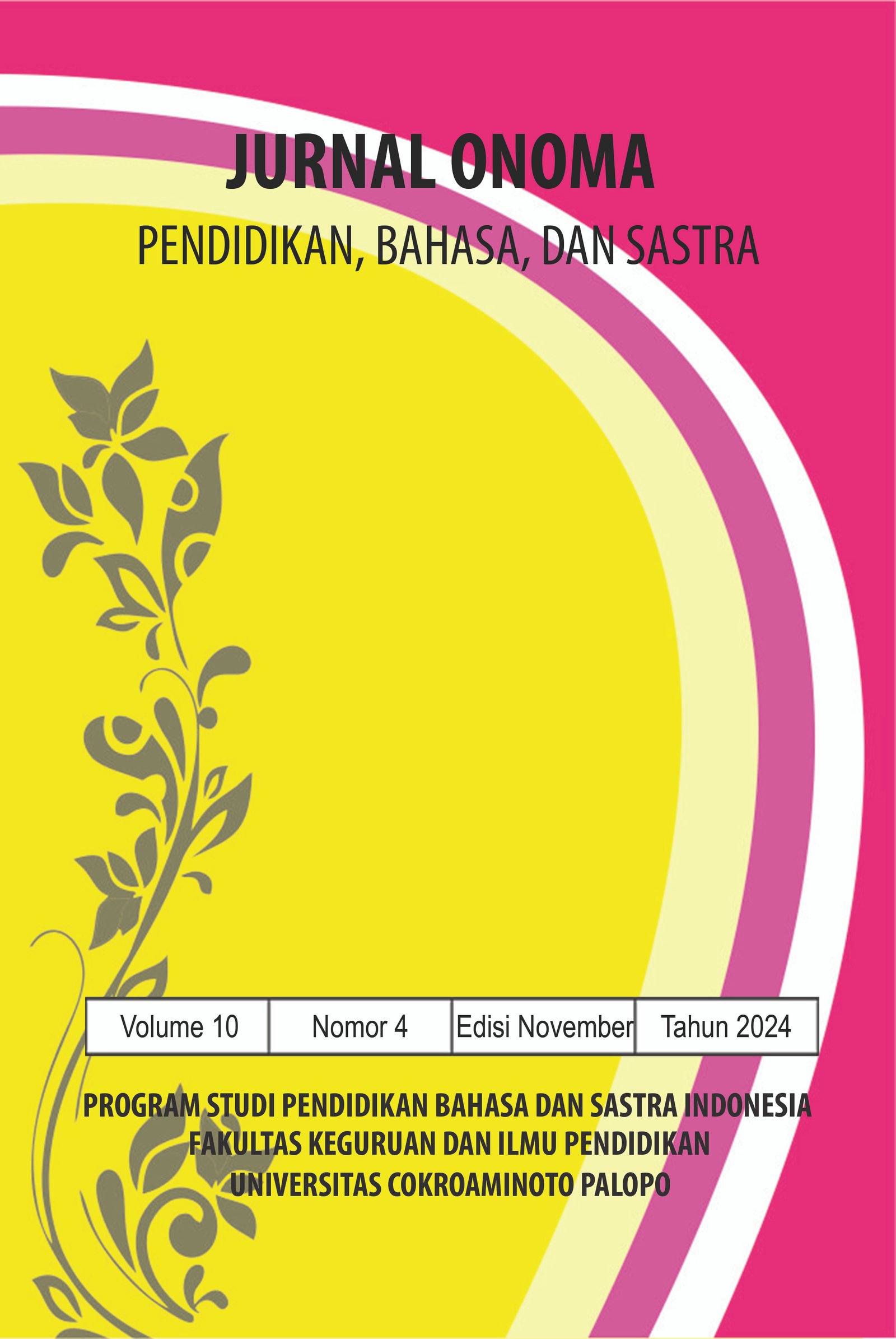Analisis Isi Buku Pelajaran Mahir Berbahasa Indonesia untuk SMP/MTs Kelas VII Kurikulum Merdeka
https://doi.org/10.30605/onoma.v10i4.4687
Keywords:
Buku, Bahasa Indonesia, SMPAbstract
Penelitian ini bertujuan untuk menganalisis komponen isi dalam buku pelajaran Mahir Berbahasa Indonesia untuk SMP/MTs Kelas VII. Buku pelajaran Mahir Berbahasa Indonesia untuk SMP/MTs Kelas VII merupakan salah satu buku berbasis Kurikulum Merdeka yang diterbitkan Erlangga. Metode penelitian yang digunakan adalah kualitatif deskriptif, yakni menganalisis data secara deskriptif fakta yang sesuai dengan data yang diperoleh untuk menunjukkan komponen isi dalam buku tersebut. Data dikumpulkan dengan teknik dokumentasi. Berdasarkan penelitian yang telah dilakukan, diperoleh hasil sebagai berikut, (1) kesesuain isi dengan kompetensi memuat enam kompetensi, yaitu menyimak, membaca, menulis, mempresentasikan, serta berbicara , (2) kebenaran substansi materi memuat dua teks dengan materi fiksi dan lima teks dengan materi fakta/ nonfiksi, (3) relevan dengan kurikulum memuat kesesuaian dengan capaian pembelajaran Kemdikbud, dan (4) memuat link berbagai sumber, keseluruhan teks memuat link video pembelajaran, audio pembelajaran, dan CBT soal remedial maupun pengayaan.
Downloads
References
Anton, M. (2005). Kemampuan Berbahasa Indonesia. Jakarta: Balai Pustaka.
Budiman, A., Yusra, H., & Sinaga, A. (2023). Analisis kesesuaian soal pembelajaran tengah semester dengan buku bahasa indonesia terbitan puskurbuk tahun 2021. Jurnal Onoma: Pendidikan, Bahasa dan Sastra. Vol. 9, No. 1. https://doi.org/10.30605/onoma.v8i2.2304 DOI: https://doi.org/10.30605/onoma.v8i2.2304
Suparman, S. (2024). Analisisi Lagu Iwan Fals Menggunakan Analisis Semiotik Roland Barthes. Jurnal Vokatif: Pendidikan Bahasa, Kebahasaan, Dan Sastra, 1(1), 21-32.
Chomsin, Widodo. (2008). Panduan Menyusun Bahan Ajar Berbasis Kompetensi. Jakarta: PT Elec Media Komputindo.
Kurniasih, Dwi. (2021). Analisis Bahan Ajar Bahasa Indonesia Bagi Penutur Asing (BIPA) Sahabatku Indonesia Tingkat Dasar. Madah: Jurnal Bahasa dan Sastra. Vol. 12, No. 1. http://dx.doi.org/10.26499/madah.v?i?.? DOI: https://doi.org/10.31503/madah.v12i1.305
Mhb, R. J., & Mukhlis, M. (2023) Keterampilan Abad 21 Buku Teks Bahasa Indonesia pada Kelas X Terbitan Kemdikbud. Jurnal Onoma: Pendidikan, Bahasa dan Sastra. Vol. 9, No. 1. https://doi.org/10.30605/onoma.v9i1.2292 DOI: https://doi.org/10.30605/onoma.v9i1.2292
Moleong, L. (2000). Metode Penelitian Kualitatif. Bandung: Remaja Rosdakarya.
Muslich, Mansur. (2010). Text Book Writing. Jakarta: Ar-Ruzz Media.
Sari, Rati Melda. (2019). Analisis Kebijakan Merdeka Belajar Sebagai Strategi Peningkatan Mutu Pendidikan. Jurnal Manajemen Pendidikan Islam UIN Imam Bonjol Padang. Vol. 1, No. 1. DOI: https://doi.org/10.15548/p-prokurasi.v1i1.3326
Siagian, Beslina Afriani. (2016). Analisis Kesesuaian Isi Buku Teks Bahasa Indonesia Berbasis Kurikulum 2013. JURNAL Suluh Pendidikan FKIP UHN. Vol. 3, No. 1.
Wahono & Sawali. (2021). Mahir Berbahasa Indonesia untuk SMP/MTs Kelas VII. Jakarta: Erlangga.
Downloads
Published
How to Cite
License
In submitting the manuscript to the journal, the authors certify that:
- They are authorized by their co-authors to enter into these arrangements.
- The work described has not been formally published before, except in the form of an abstract or as part of a published lecture, review, thesis, or overlay journal.
- That it is not under consideration for publication elsewhere,
- That its publication has been approved by all the author(s) and by the responsible authorities – tacitly or explicitly – of the institutes where the work has been carried out.
- They secure the right to reproduce any material that has already been published or copyrighted elsewhere.
- They agree to the following license and copyright agreement.
License and Copyright Agreement
Authors who publish with Onoma Journal: Education, Languages??, and Literature agree to the following terms:
- Authors retain copyright and grant the journal right of first publication with the work simultaneously licensed under Creative Commons Attribution License (CC BY 4.0) that allows others to share the work with an acknowledgment of the work's authorship and initial publication in this journal.
- Authors are able to enter into separate, additional contractual arrangements for the non-exclusive distribution of the journal's published version of the work (e.g., post it to an institutional repository or publish it in a book), with an acknowledgment of its initial publication in this journal.
- Authors are permitted and encouraged to post their work online (e.g., in institutional repositories or on their website) prior to and during the submission process, as it can lead to productive exchanges, as well as earlier and greater citation of published work.

















